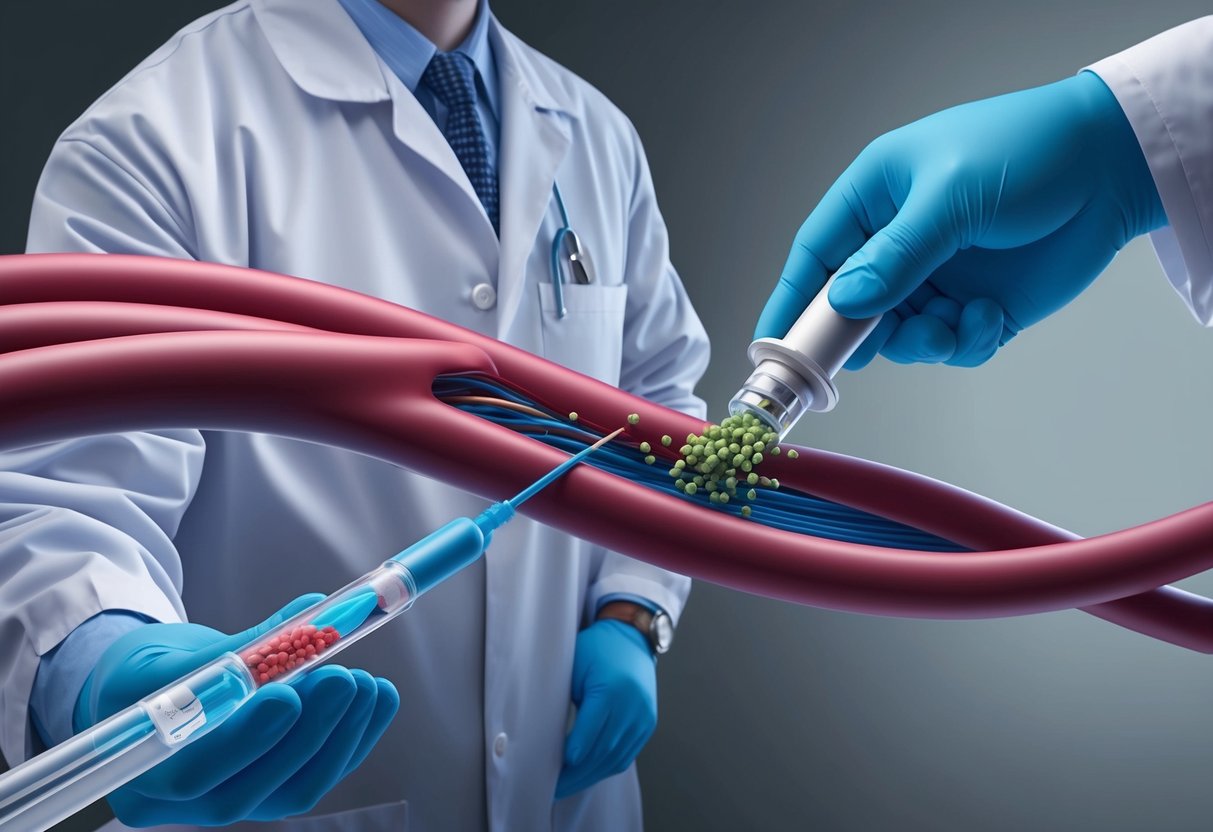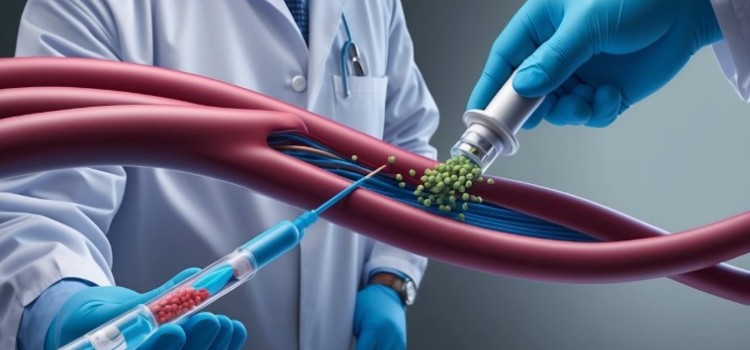A Minimally Invasive Treatment for BPH, Prostate Artery Embolization Procedure Explained
Prostate artery embolization (PAE) has emerged as a promising treatment for benign prostatic hyperplasia (BPH), a common condition affecting many men as they age. This minimally invasive procedure offers relief from lower urinary tract symptoms caused by an enlarged prostate gland. PAE involves the targeted release of microscopic particles into the arteries that supply blood to the prostate, reducing its size and alleviating symptoms.

The procedure is typically performed on an outpatient basis by an interventional radiologist.
It provides an alternative to traditional surgical options for BPH, potentially offering fewer complications and a quicker recovery time.
As with any medical procedure, patients should consult with their healthcare providers to determine if PAE is suitable for their specific condition.
Key Takeaways
- PAE is a minimally invasive treatment for BPH that reduces prostate size and improves urinary symptoms
- PAE reduces blood flow to the prostate by reducing the size of the arteries supplying blood
- The procedure is performed by interventional radiologists on an outpatient basis
- PAE offers a potential alternative to traditional surgical options for treating BPH
Understanding Prostate Artery Embolization
Prostate artery embolization (PAE) is an innovative, minimally invasive procedure for treating benign prostatic hyperplasia (BPH). This technique targets the blood supply to the prostate gland, offering an alternative to traditional surgical interventions.
Basics of Prostate Artery Embolization (PAE)
PAE is a procedure that reduces blood flow to the prostate gland. A trained interventional radiologist performs the treatment by inserting a catheter into an artery in the groin or wrist. They guide this catheter to the prostatic arteries using specialized imaging techniques.
Once in position, tiny particles are injected through the catheter. These particles block the blood supply to the prostate, causing it to shrink in size. The reduced prostate size alleviates urinary symptoms associated with BPH.
PAE is typically performed under local anesthesia. Patients often experience minimal discomfort and can usually return home the same day.
The Role of the Prostatic Artery in BPH
In BPH, the prostate gland enlarges, compressing the urethra and causing urinary difficulties. The prostatic arteries play a crucial role in this process by supplying blood to the enlarged gland.
These arteries nourish the prostate tissue, supporting its growth. As BPH progresses, the increased blood flow contributes to the gland’s continued enlargement.
By targeting these arteries, PAE effectively reduces the prostate’s blood supply. This leads to shrinkage of the gland and improvement in urinary symptoms.
PAE as a Minimally Invasive Intervention
PAE offers several advantages as a minimally invasive treatment for BPH. Unlike traditional surgical options, it does not require general anesthesia or a hospital stay.
The procedure involves only a small incision for catheter insertion. This results in less pain, faster recovery, and lower risk of complications compared to open surgery.
PAE preserves sexual function and continence, which can be affected by other BPH treatments. It’s particularly beneficial for patients who are poor surgical candidates or prefer a non-surgical approach.
While effective for many patients, PAE may not be suitable for all cases of BPH. A thorough evaluation by a specialist can determine if it’s the right option for an individual’s specific condition.
Procedure and Efficacy
Prostate artery embolization (PAE) is a minimally invasive procedure that offers relief for lower urinary tract symptoms caused by benign prostatic hyperplasia. The technique, its safety profile, and comparative efficacy to traditional treatments are key considerations for patients and healthcare providers.
The PAE Procedure Explained
PAE is performed by an interventional radiologist using advanced imaging techniques. The procedure begins with a small incision in the groin or wrist to access the arterial system. A catheter is then guided through the blood vessels to the prostate arteries.
Once in position, tiny particles are injected to block blood flow to the prostate, causing it to shrink. This reduces pressure on the urethra, alleviating urinary symptoms. The entire process typically takes 1-4 hours and is often performed under local anesthesia.
Patients may experience mild discomfort during recovery, but many report significant improvement in urinary symptoms within days or weeks after the procedure.
Safety, Side Effects, and Quality of Life Post-PAE
PAE has shown a favorable safety profile with minimal risk of serious complications. Common side effects include mild pain, urinary burning, and temporary blood in the urine or semen. These typically resolve within a few days to weeks.
Studies have demonstrated improvements in quality of life and urinary symptoms following PAE. Patients often experience:
- Reduced urinary frequency and urgency
- Improved urinary flow
- Decreased nocturia (nighttime urination)
Sexual function is generally preserved, with a lower risk of erectile dysfunction compared to some surgical alternatives. The International Prostate Symptom Score (IPSS) is commonly used to assess symptom improvement post-procedure.
Comparing PAE with Traditional Treatments
PAE offers several advantages over traditional treatments like transurethral resection of the prostate (TURP):
- Minimally invasive with shorter recovery time
- Lower risk of urinary incontinence and sexual side effects
- Suitable for patients with larger prostates or those unfit for surgery
However, PAE may not be as effective for all patients, and symptom improvement can be more gradual compared to surgical options. Long-term efficacy data is still being gathered, as PAE is a relatively new procedure.
A comparison of outcomes:
| Aspect | PAE | TURP |
|---|---|---|
| Invasiveness | Minimal | Moderate |
| Anesthesia | Local | General/Spinal |
| Hospital Stay | Outpatient | 1-3 days |
| Recovery Time | 1-7 days | 2-4 weeks |
| Symptom Relief | Gradual | Immediate |
| Risk of Erectile Dysfunction | Low | Higher |
Patients should consult with both a urologist and an interventional radiologist to determine the most appropriate treatment for their specific condition.
Frequently Asked Questions

Prostate artery embolization is a minimally invasive procedure for treating enlarged prostates. Patients often have questions about its effects, suitability, recovery, and technique.
What are the potential side effects of prostate artery embolization?
Common side effects include temporary pelvic pain and urinary burning. Some patients may experience mild fever or fatigue for a few days after the procedure.
More rare side effects can include urinary tract infection or temporary worsening of urinary symptoms. Serious complications are uncommon with prostate artery embolization.
How long can the effects of prostate artery embolization be expected to last?
The effects of prostate artery embolization can last for several years. Many patients experience sustained symptom improvement for 3-5 years or longer after the procedure.
Regular follow-up appointments help monitor the long-term effectiveness. Some patients may require additional treatments if symptoms return over time.
What criteria determine the suitability of a patient for prostate artery embolization?
Ideal candidates have moderate to severe urinary symptoms due to an enlarged prostate. Patients should have failed or be unwilling to continue medical therapy.
Good kidney function and the absence of certain urological conditions are important. A detailed evaluation by an interventional radiologist determines final suitability.
What is the recovery process like after undergoing a prostate artery embolization procedure?
Recovery is typically quick, with most patients returning home the same day. Mild discomfort may occur for a few days but is manageable with over-the-counter pain medication.
Patients can usually resume normal activities within 24-48 hours. Gradual improvement in urinary symptoms occurs over several weeks to months following the procedure.
How do medical professionals perform prostate artery embolization?
An interventional radiologist performs the procedure using imaging guidance. A small catheter is inserted through an artery in the groin or wrist.
Tiny particles are injected to block blood flow to the prostate, causing it to shrink. The procedure typically takes 1-3 hours and is done under local anesthesia.
Can the prostate artery embolization procedure be performed more than once on a patient?
Prostate artery embolization can be repeated if necessary. This may be considered if symptoms return after an initial successful treatment.
The decision to repeat the procedure depends on various factors, including the patient’s overall health and the effectiveness of the first embolization.

